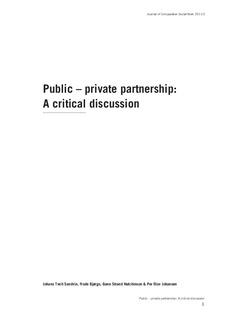| dc.contributor.author | Sandvin, Johans Tveit | |
| dc.contributor.author | Bjørgo, Frode | |
| dc.contributor.author | Hutchinson, Gunn Strand | |
| dc.contributor.author | Johansen, Per Olav | |
| dc.date.accessioned | 2015-07-09T12:39:28Z | |
| dc.date.accessioned | 2015-07-10T10:01:51Z | |
| dc.date.available | 2015-07-09T12:39:28Z | |
| dc.date.available | 2015-07-10T10:01:51Z | |
| dc.date.issued | 2011 | |
| dc.identifier.citation | Sandvin, J. T., Bjørgo, F., Hutchinson, G. S. & Johansen, P. O. (2011). Public – private partnership: A critical discussion. Journal of Comparative Social Work, 6(2). Retrieved from http://journal.uia.no/ index.php/JCSW/article/view/231/166 | nb_NO |
| dc.identifier.issn | 0809-9936 | |
| dc.identifier.uri | http://hdl.handle.net/11250/293026 | |
| dc.description.abstract | Public-private partnerships have long been highly valued in Western welfare states, and the valuation of such cooperation has become even stronger in light of last year’s economic turbulence, particularly with voluntary non-profit organizations (VNPOs). At the same time, the voluntary sector is changing. The broad popular movements have generally declined in favour of more individual interests as the basis for forming VNPOs, and those organisations still involved in the provision of social services are becoming more and more similar to public service, due to requirements placed on them by the public sector. This is believed to have consequences for the value of such cooperation. If voluntary organisations in public services – or other private organisations for the matter – are becoming copies of public services, there is not much value to be gained from such cooperation, except for some financial gain.In this article, we argue that this conclusion is based on a rather narrow perception of public-voluntary cooperation. Research and debate on such cooperation are mainly preoccupied by what we call supplementary relations, in which voluntary organizations are assessed according to whether they can deliver cheaper or better services than the public sector. Based on an example of public-voluntary cooperation in preventive social work among young adults in Norway, the article show that public-voluntary collaboration can be truly valuable when it is based on a complimentary relation, in which parties collaborate because they command different resources equally important to the task at hand. | nb_NO |
| dc.language.iso | eng | nb_NO |
| dc.publisher | Universitetet i Nordland | nb_NO |
| dc.rights | Navngivelse-Ikkekommersiell-IngenBearbeidelse 3.0 Norge | * |
| dc.rights.uri | http://creativecommons.org/licenses/by-nc-nd/3.0/no/ | * |
| dc.title | Public – private partnership: A critical discussion | nb_NO |
| dc.type | Journal article | nb_NO |
| dc.type | Peer reviewed | nb_NO |
| dc.date.updated | 2015-07-09T12:39:28Z | |
| dc.subject.nsi | VDP::Social science: 200::Political science and organizational theory: 240::Public and private administration: 242 | nb_NO |
| dc.source.pagenumber | 11 | nb_NO |
| dc.source.volume | 6 | nb_NO |
| dc.source.journal | Journal of Comparative Social Work | nb_NO |
| dc.source.issue | 2 | nb_NO |
| dc.identifier.cristin | 884036 | |

